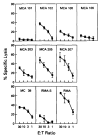Defective presentation of endogenous antigens by a murine sarcoma. Implications for the failure of an anti-tumor immune response
- PMID: 1907999
- PMCID: PMC1950464
Defective presentation of endogenous antigens by a murine sarcoma. Implications for the failure of an anti-tumor immune response
Abstract
MHC class I-restricted CTL play a central role in the immune response against methylcholanthrene (MCA)-induced sarcomas in mice. We, therefore, hypothesized that MCA-induced tumors may evade immune recognition by failing to present Ag to CD8+ CTL. Of a number of previously described MCA-induced sarcomas, one, MCA 101, fails to induce CTL, is nonimmunogenic, and grows rapidly and lethally in nonimmunosuppressed recipients. To better understand the nonimmunogenicity of MCA 101 we examined its ability to present foreign Ag to CTL. Unlike immunogenic sarcomas, MCA 101 failed to present endogenously synthesized influenza virus Ag to influenza virus-specific CTL. The deficiency in presentation of endogenous Ag by MCA 101 was attributed to a markedly reduced rate of synthesis of class I molecules because up-regulation of class I synthesis by IFN-gamma greatly increased the presentation of influenza A virus Ag. Despite low levels of cell surface class I expression, MCA 101 presented exogenous peptide Ag to anti-influenza CTL with efficiency similar to immunogenic MCA sarcoma cell lines. These findings could not be attributed to deficiencies in class I assembly or transport, as has been suggested by others who have studied mutant cells with defective Ag presentation. Furthermore, our studies suggest that some tumor cells can escape recognition by CTL and subsequent immune eradication by suppressing presentation of endogenous Ag.
Figures





Similar articles
-
LMP2+ proteasomes are required for the presentation of specific antigens to cytotoxic T lymphocytes.Curr Biol. 1995 Aug 1;5(8):923-30. doi: 10.1016/s0960-9822(95)00182-5. Curr Biol. 1995. PMID: 7583150
-
A nonimmunogenic sarcoma transduced with the cDNA for interferon gamma elicits CD8+ T cells against the wild-type tumor: correlation with antigen presentation capability.J Exp Med. 1992 Jun 1;175(6):1423-31. doi: 10.1084/jem.175.6.1423. J Exp Med. 1992. PMID: 1588273 Free PMC article.
-
Differential recruitment of viral and allo-epitopes into the MHC class I antigen processing pathway of a novel mutant of Ltk- cells. HSV/MHC class I restriction/immune recognition/antigen processing/antigen presentation/influenza virus.J Immunol. 1993 Apr 15;150(8 Pt 1):3170-9. J Immunol. 1993. PMID: 7682234
-
The recognition of a viral antigenic moiety by class I MHC-restricted cytolytic T lymphocytes is limited by the availability of the endogenously processed antigen.J Immunol. 1990 Nov 15;145(10):3188-93. J Immunol. 1990. PMID: 1700000
-
The influenza virus-infected host cell, a target for the immune response.Behring Inst Mitt. 1991 Jul;(89):1-11. Behring Inst Mitt. 1991. PMID: 1930089 Review.
Cited by
-
Cytokine enhancement of DNA immunization leads to effective treatment of established pulmonary metastases.J Immunol. 1996 Jan 1;156(1):238-45. J Immunol. 1996. PMID: 8598468 Free PMC article.
-
Vaccination for melanoma.Curr Oncol Rep. 2000 Jul;2(4):292-9. doi: 10.1007/s11912-000-0021-0. Curr Oncol Rep. 2000. PMID: 11122856 Review.
-
Locus-specific analysis of human leukocyte antigen class I expression in melanoma cell lines.J Immunother Emphasis Tumor Immunol. 1994 Jul;16(1):13-23. doi: 10.1097/00002371-199407000-00002. J Immunother Emphasis Tumor Immunol. 1994. PMID: 8081556 Free PMC article.
-
The Chinese Herbal Mixture Tien-Hsien Liquid Augments the Anticancer Immunity in Tumor Cell-Vaccinated Mice.Integr Cancer Ther. 2017 Sep;16(3):319-328. doi: 10.1177/1534735416651492. Epub 2016 Jun 1. Integr Cancer Ther. 2017. PMID: 27252074 Free PMC article.
-
Ablation of Cbl-b provides protection against transplanted and spontaneous tumors.J Clin Invest. 2007 Apr;117(4):1029-36. doi: 10.1172/JCI29472. Epub 2007 Mar 15. J Clin Invest. 2007. PMID: 17364027 Free PMC article.
References
-
- Klein G, Sjögren HO, Klein E, Hellström KE. Demonstration of resistance against methylcholanthrene-induced sarcomas in the primary autochthonous host. Cancer Res. 1960;20:1561. - PubMed
-
- Prehn RT, Main JM. Immunity to methylcholanthrene-induced sarcomas. JNCI. 1957;18:769. - PubMed
-
- Greenberg PD, Cheever MA, Fefer A. H-2 restriction of adoptive immunotherapy of advanced tumors. J Immunol. 1981;126:2100. - PubMed
-
- Shimizu K, Shen F-W. Role of different T cell set in the rejection of syngeneic chemically induced tumors. J Immunol. 1979;122:1162. - PubMed
-
- Schreiber H, Ward PL, Rowley DA, Stauss HJ. Unique tumor-specific antigens. Annu Rev Immunol. 1988;6:465. - PubMed
MeSH terms
Substances
Grants and funding
LinkOut - more resources
Full Text Sources
Other Literature Sources
Research Materials
